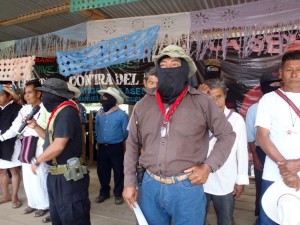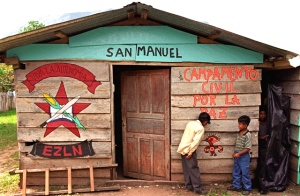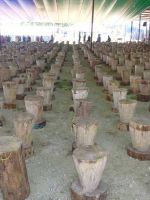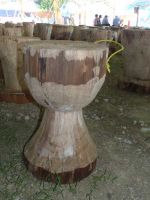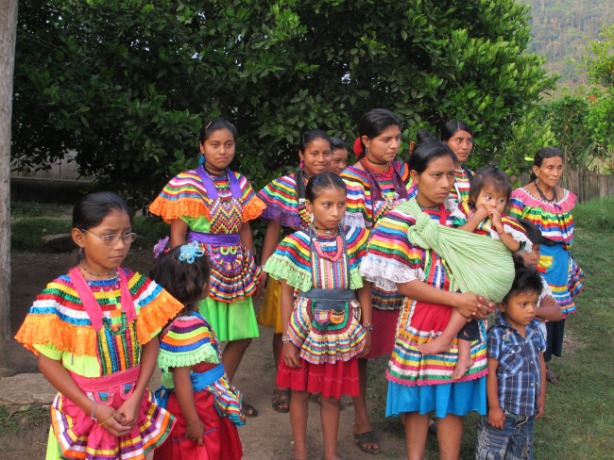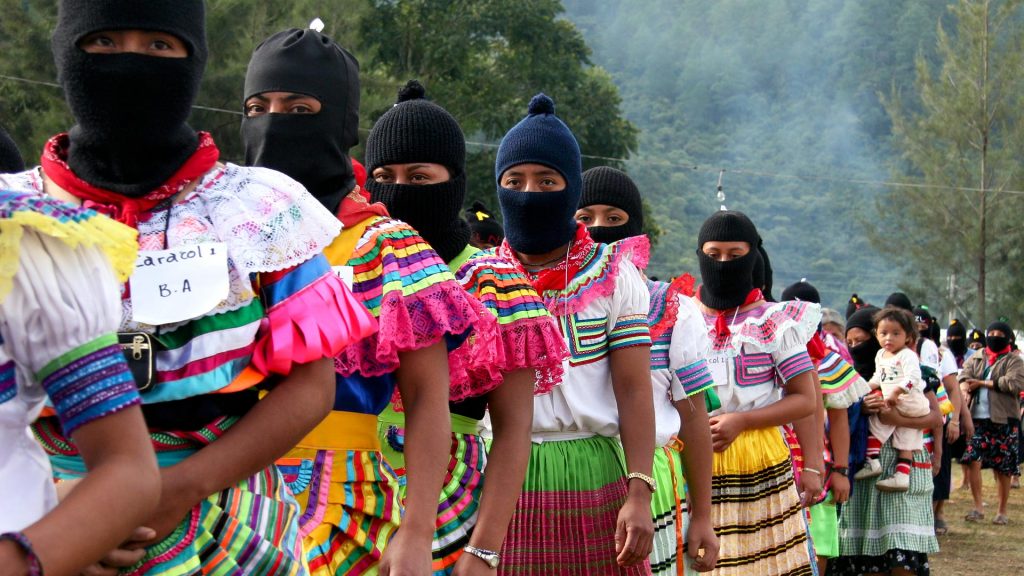Sorry, this entry is only available in Español. For the sake of viewer convenience, the content is shown below in the alternative language. You may click the link to switch the active language.
Fuente: Chiapas Paralelo
Encapuchados bases de apoyo del EZLN. Foto: Elizabeth Ruiz.
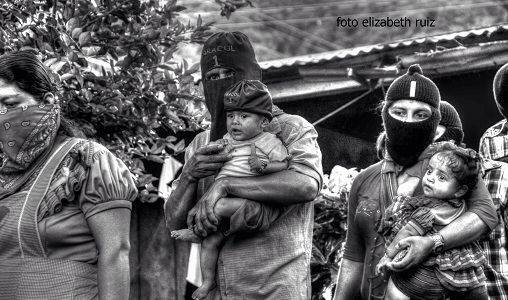
Nunca nos van a perdonar el habernos levantado en armas…
Sub Marcos. 1994.
1.- Un obligado recuento. (La lectura es opcional. Puede usted ir a los puntos siguientes y ahí ve si regresa)
Cuando la revista Proceso lanzó en Septiembre de 2010 su 30 Edición Especial, en su portada la fotografía de Carlos Salinas de Gortari de espaldas frente al asta bandera de la Plaza de la Constitución con el título La obsesión del poder, el contenido no dejaba duda de que Salinas estaba de regreso. Pleno y con un plan estratégico de poder para lo que le resta de vida y legado para las siguientes generaciones neoliberales en México. Al señor le habían bastado una década, de1995 a 2005, para acumular fuerzas y retornar.
En esa ruta, en 2005, había lanzado a Peña Nieto al gobierno del Estado de México. En 2008 -adelantando calendarios de su Democracia y pasándose por el arco del triunfo a la estructura del PRI y a los tribunales electorales-, candidateó a Peña Nietoal gobierno de la República.
En 2011 – como ave de mal agüero-, escribí:
“Carlos Salinas de Gortari (…) está de vuelta y muy probablemente con una factura por cobrar en el bolsillo. De ganar las elecciones en el Estado de México en 2011y luego las presidenciales con Peña Nieto en 2012, con la “divisa de la paz”, no podemos esperar otra cosa que intente pasarle la cuenta el EZLN. Como la militarización en Chiapas y el emplazamiento estratégico y táctico de las tropas está resuelto, es muy probable que se afinen los planes de contrainsurgencia en Chiapas empezando con un plan de ‘combate a la pobreza’ a fondo y con mayor incidencia en la llamada ‘zona de conflicto’, en el que intervengan los tres niveles de gobierno (…) para continuar ‘quitándole agua al pez’. En su momento y de ser necesario, agudizar la inestabilidad en el área dándole mayor beligerancia a los grupos confrontados con los zapatistas y, en su caso, poner en activo a los grupos paramilitares. Como anillo al dedo le cae a Salinas, (…) el Frente de Guerra en la Frontera Sur para el ‘combate a la delincuencia organizada’ (…), las acciones del Ejército federal tendrían una excelente coartada para incursionar pueblos y comunidades zapatistas y atacar, dado el caso, al EZLN.” (Gaspar Morquecho, 2012: La Democracia Neoliberal, Chiapas y el EZLN en la coyuntura. 19/04/2011) http://alainet.org/active/46835&lang=es
En 2012, Salinas- Peña Nieto ganaban de calle las elecciones derrotando a Mota y al incauto Peje que se la creyó que iba a vencer al candidato del innombrable. En el trayecto Salinas – Peña Nieto se habían encontrado con la rebeldía de una franja de jóvenes de la Ibero y se nació el #YoSoy132.
En esa ruta Salinas-Peña Nieto habían creado un aparato político para los cambios estructurales en México: el Pacto por México. Ahí se articularon las tres principales fuerzas de control político electorales: El PRI, el PAN, y su izquierda, el PRD.
La toma de posesión de Salinas-Peña Nieto fue blindada y la violencia en las calles contra los manifestantes que protestaron por la imposición fue desproporcionada. Ahí cayó gravemente herido el compa Kuy.
En Chiapas, el relingo del güerito Velasco, con más del 70% de los votos ganaban de calle la gubernatura de Chiapas. Los descompuestos movimientos sociales habían pactado sus votos con el candidato de del PRI-Verde.
El 21 de Diciembre de 2012, cuarenta mil bases de apoyo se movilizaron en cinco cabeceras municipales: San Cristóbal de Las Casas, Ocosingo, Altamirano, Palenque y Las Margaritas, territorios que corresponden a cada uno de los Caracoles zapatistas y sede de las Juntas de Buen Gobierno. El 29 de diciembre Marcos escribió:
“Claro, me dirán ustedes que no estas personas mandan, que en realidad es Carlos Salinas de Gortari quien le dicta a Enrique Peña Nieto lo que debe de hacerse (…).
Ok, ok, ok. Carlos Salinas de Gortari. ¿No es quien saqueó como ningún otro las riquezas nacionales durante su mandato? (…). ¿No es quien devastó el campo mexicano con sus reformas al artículo 27 constitucional? ¿No es a quien le amargamos el brindis de año nuevo en la madrugada de 1994? ¿No es quien vio destrozados sus sueños dictatoriales por unos rifles de madera? ¿No es quien mandó asesinar a Luis Donaldo Colosio Murrieta? ¿No es quien hizo el ridículo con su huelga de hambre en 1995? ¿No es quien, el pasado 21 de diciembre, preguntaba frenético por el teléfono rojo: ¿qué dicen?, ¿qué dicen? y quien sintió un escalofrío en su espalda cuando le respondieron: nada, están en absoluto silencio?” (Sub Marcos, Comunicado1,A quien corresponda allá arriba. 29 de Diciembre del 2012.
2.- 2013: Primer año de Salinas – Peña Nieto (La lectura es opcional. Puede usted ir a los puntos siguientes y ahí ve si regresa)
Se movieron con inteligencia, fuerza y perversidad para imponer las Reformas Estructurales. El Estado neoliberal reformó la Ley de Amparo para quedar amparado. Cronológicamente, como el movimiento sindical es prácticamente inexistente, lanzó primero y se aprobó sin dificultad la Reforma Laboral; Para la Reforma Educativa metió a la cárcel a la profesora que se puso a jugar a las fuercitas y mandó por la ruta del desgaste a lo que queda del movimiento magisterial a sabiendas que mientras se acercaban las vacaciones y el cobro del aguinaldo el Huracán se iba a disipar. Para la Reforma Hacendaría el PRI se apoyó en el PRD y para la energética en el PAN. Así, el Pacto por México fue un medio tubo donde un PRI en patineta se deslizaba hacia su derecha y hacia su izquierda para imponer 4 reformas estructurales – como deben ser -, estratégicas.
Paralelamente, habían diseñado un paquete de iniciativas, medidas y acciones compensatorias de atracción, es decir, para llevar a su terreno, en concreto a la poderosa Secretaría de Gobernación (SEGOB), a una diversidad de movimientos sociales expectantes. De esa forma se aprobó la Ley de Víctimas, se fortaleció la Comisión para la Prevención de la Discriminación (CONAPRED), y se mantuvo ocupados a las y los trabajadores de Mexicana de Aviación y del SME. A estos últimos les concedieron 1,300 pensiones vitalicias.
En marzo de 2013, como una medida legitimadora, Salinas-Peña Nieto inició la ofensiva contra el “crimen organizado” en Michoacán apoyándose en las fuerzas comunitarias de autodefensa”, puso en prisión Gastón Azcárraga Andrade responsable de la quiebra de Mexicana y a El Chapo.
Para el Sureste Mexicano, el gobierno de Salinas-Peña Nieto diseñó desde la SEGOB la Ruta para el Diálogo en Chiapas: En el Congreso se acordó desempolvar a la Comisión de Concordia y Pacificación (COCOPA). El experimentado arquitecto, exlegislador, 4 veces cocopo, y se dice que con Marcos… ‘canicas’,Jaime Martínez Veloz fue nombrado Comisionado para el Diálogo con los Pueblos Indios de México. Se liberó al profe Patishtán previa modificación del Código Federal para fortalecer la figura presidencial. Y se anunció la reposición del procedimiento legislativo para la reforma a la Ley Indígena que “retomaría los acuerdos de San Andrés” y se actualizarían con las “disposiciones de los organismos internacionales” correspondientes.
En Noviembre de 2013, Martínez Veloz declaró que el 2014 sería el año de los derechos de los pueblos indios de México y que para febrero de este año – 18 aniversario de la firma de los Acuerdos de San Andrés – se presentaría el renovado proyecto de Ley Indígena.
Una de las medidas con doble filo de Salinas-Peña Nieto fue el lanzamiento de otra pretenciosa medida legitimadora: la Cruzada Contra el Hambre. El acto fue en el municipio de Las Margaritas (21 de enero de 2013), un mes después de la movilización de las Bases de Apoyo Zapatistas (BAZ). Fue el segundo mensaje de Salinas-Peña nieto a Marcos y al EZLN. El municipio fue escogido con malicia. En Las Margaritas, Carlos Salinas tuvo su primer “encuentro” con los zapatistas cuando fue a inaugurar la Clínica del IMSS en Guadalupe Tepeyac en 1993 y sede la Convención Nacional Democrática en agosto de 1994. Como recordarán, El Aguascalientes fue tomado y destruido por el ejército Federal en febrero de 1995.
Marcos respondió ironizado la mediocre coreografía del acto de lanzamiento de la Cruzada y enviando el cartón del dedito obsceno. (21 de Enero 2013)
Un mes después, Salinas – Peña Nieto escogieron – en Los Altos de Chiapas – al municipio de Zinacantán para lanzar el programa SinHambre, una de las 70 acciones de la Cruzada. Para tal efecto acarrearon a unos 10 mil indios tzotziles de la región e invitaron a Lula el ex presidente brasileño que llevó con éxito el programa de Hambre Cero en su país. (7 de marzo de 2013)
En 2013, el EZLN tomó la iniciativa política y organizó las Escuelitas Zapatistas, y se propuso el acercamiento con las organizaciones indígenas del Congreso Nacional Indígena (CNI), a las/os adherentes a la Sexta y con los movimientos sociales. El EZLN denunció que la Fuerza Aérea Mexicana sobrevoló algunos Caracoles. (14 de agosto 2013)
3.- 2014: la ofensiva de Salinas-Peña Nieto: La guerra total: En todos los terrenos:
(La lectura es opcional. Puede usted ir a los puntos siguientes y ahí ve si regresa.
Una vez que fueron impuestas las Reformas Estructurales la SEGOB cerró las ventanillas, concluyó en lo fundamental la interlocución y mandó por un tubo a buena parte de los que había atraído a su terreno. Los mandó a gestionar sus asuntos a la Secretaría o gobierno correspondiente. Por ahí dejó funcionando a un subsecretario que con habilidad entretiene a las “organizaciones sociales”.
Se declaró la quiebra de Mexicana de Aviación. A los pensionados del SME no se les ha entregado ni un quito, ni se les ha recontratado.
¿Recuerdan la enjabonada que le dieron a Peña Nieto en la Ibero? Resulta que el gobierno suspendió la construcción de un edificio educativo de esa institución y le impuso una multa millonaria.
Algo más, el gobierno federal empezó a desacreditar, a encarcelar y procesar a integrantes de las fuerzas comunitarias de Michoacán, los partieron y domesticaron a una facción. Los convirtieron en Fuerza Rural. Algo semejante a lo que Camacho Solís le ofreció a la delegación del EZLN durante los diálogos en la Catedral de San Cristóbal en 1994: “Nos quieren convertir en guardabosques. Nos ofrecen más armas con tal de que firmemos la paz”, comentó Marcos a un grupo de personas que después de las pláticas en Catedral los acompañamos de regreso a la Selva. Hablando de catedrales, resulta que en el reciente encuentro de Salinas – Peña Nieto con el Episcopado Mexicano, los Príncipes de la Iglesia se convirtieron en lacayos, dieron su bendición a la guerra de Peña a la Cruzada contra el Hambre y le peinaron el copetito.
En Chiapas, el gobierno federal reafirmó su presencia:
El 12 de Febrero, Salinas – Peña Nieto Inauguró el Aeropuerto Internacional de Palenque y se comprometió a construir la autopista de Palenque-San Cristóbal de las Casas. Se informó que el anteproyecto de la obra (trazo y tiempo de ejecución) estaría listo en este mes de mayo. Para entonces el gobierno de Chiapas había comprado a las autoridades de los gobiernos municipales, de los ejidos y comunidades. Los presidentes municipales, sean del PRI, del Verde o del PRD se han dedicado a hacer la ficha políticade las personas o grupos que se oponen a la autopista. Otras complicaciones en la lucha contra la construcción de esa vía: no les interesa a las comunidades que no van a ser afectadas; en una misma comunidad hay grupos que se oponen al proyecto, otros que están dispuestos a negociar y sacar alguna ventaja, y otros que definitivamente lo apoyan.
Por su parte, la Comisión Federal de Electricidad puso en marcha la construcción de la hidroeléctrica de Chicoasén II, en Chiapas. Otra en Las Cruces, en Nayarit. (Ver: Presidencia de la República. 28 de marzo 2014)
El 31 de marzo, el EZLN anunció que en la semana del 26 al 30 de mayo de 2014 se reunirían con representantes de los diversos pueblos originarios y organizaciones indígenas. Que el domingo 1 de junio, harían un sencillo homenaje a Luis Villoro y que del 2 al 8 de junio de se realizaría un seminario con el tema de “ÉTICA FRENTE AL DESPOJO”. En seguida, se agudizó el hostigamiento y se incrementaron las provocaciones al EZLN. Tres casos:
1.- La agresión a BAZ de una de las CIOAC en la comunidad 10 de Abril y el ultraje ahí mismo de las religiosas del hospital de Altamirano (4 de febrero 2014);
2.- El brutal asesinato del compañero adherente a la Sexta en Bachajón (21 de marzo 2014)
3.- En Las Margaritas, la agresión a las BAZ y el brutal asesinato de Galeano en La Realidad por otra de las CIOAC (2 de mayo 2014).
Después del asesinato del compa Galeano el EZLN suspendió esas actividades.
Si usted revisa El fuego y la Palabra, el 20 y 10 de Gloria Muñoz puede constatar que a cada iniciativa política del EZLN el gobierno federal respondió con alguna medida contrainsurgente de contención.
Vámonos al territorio de la Reserva de Montes Azules. Tenemos que el 10 de Abril – aniversario de la muerte de Emiliano Zapata -, el Secretario de Gobierno de Chiapas anunció que no se iba a regularizar ninguno de los predios ocupados por campesinos indígenas.
El 30 de abril, días antes de la realización de Asamblea General de la Comunidad Zona Lacandona para el cambio de comisariado de bienes comunales, se publicó una nota de prensa en la que se informó: “Investiga la Procuraduría desaparición de Julia Carabias Lillo”
El 4 de mayo 2014, la propia Julia Carabiasdeclaró: “Fui privada de mi libertad durante dos días en la Selva Lacandona, (….) Calumnias, imperio de la ilegalidad, miseria y desesperanza conforman el caldo de cultivo de ese inaceptable episodio”….
El 14 de mayo se inició la II Fase del Operativo Frontera Sur. “800 efectivos de federales, estatales y municipales participan en el operativo Pakal para inhibir delitos de alto impacto como son el tráfico de drogas, armas y personas por este zona de la frontera entre México y Guatemala”.Es conocido también el incremento de efectivos de la Armada en esa región.
El 21 de mayo, Maderas del Pueblo denunció que se había desatado una nueva y agresiva campaña de intereses privatizadores de los estratégicos Bienes Naturales Comunes de la Selva Lacandona y de la Reserva de la biósfera de los Montes Azules, disfrazados de ‘ambientalistas’, violando los derechos indígenas y criminalizando la protesta social”.
Las agresiones en el ámbito de la salud son graves: a) Desde hace dos o tres años el Sector Salud no entrega las vacunas que año con año venían aplicando los promotores de Salud zapatistas en los Caracoles de Roberto Barrios y La Garrucha; b) En Altamirano se ultrajó a las religiosas responsables del hospital de San Carlos y se retuvo la ambulancia; c) En La Realidad la facción de la CIOAC retuvo otra ambulancia y destruyó la clínica.
Hace unos días un grupo de activistas se reunió para “analizar la coyuntura”. Para tratar de ubicarse en la rialidad. Brilló la estrechez de nuestras miras, sin embargo, lo más grave y como efecto de la guerra en Chiapas es la pérdida de confianza. A los invitados les requisaron o le sustrajeron a hurtadillas los celulares. Se ha perdido la confianza y el respeto en los “más cercanos”.
4.- El telón de fondo: el Plan Puebla Panamá, ahora Plan Mesoamericano. (La lectura opcional. Puede usted ir a los puntos siguientes y ahí lo ve si regresa)
“(…) Que los zapatistas le mandaron decir a Luis Ernesto Derbez, secretario de Relaciones Exteriores, que lo de “relanzar” el Plan Puebla Panamá debe ser al abismo, porque en tierras rebeldes no se va a permitir el mentado plan. (…) Que no es una amenaza, sino una profecía.”
Marcos. 23 de julio de 2003.
Un día de estos platicaba con entusiasmo que era importante que las comunidades indígenas se organizaran para hacer protestas en varios municipios en contra de la construcción de la Autopista San Cristóbal – Palenque. Si lo prefiere de Palenque a San Cristóbal. Una compañera casi me golpea. “¡¡¡¿Qué te pasa?!!!” preguntó con energía. Tu idea sólo refleja tu miopía política. Que no tienes ni la menor idea de lo que está en juego”, añadió. Vamos, me puso una enjabonada que me duró varios días.
Resulta que el difunto – para muchos – del PPP ahora Plan Mesoamericano está vivito y coleando: “Mira tontín, decía la compañera, la Autopista es nada en comparación al enorme proyecto de Ecoturismo en la Reserva de Montes Azules. Como el Aeropuerto Internacional de Palenque, la autopista es parte de la infraestructura para ese proyecto. Por eso tanta bulla en los últimos días: el cambio de comisariado de Bienes Comunales, el supuesto secuestro de la Carabias que tiene importantes intereses en la Reserva como sus socios, la movilización de los comuneros y ejidatarios en la zona, los operativos policiaco-militares y que el burdel – mejor conocido como Congreso – demande que se investigue el secuestro de la Carabias. En el marco de la Economía Verde, el proyecto de Ecoturismo en la Reserva es de extraordinarias dimensiones y muchos intereses están en juego”.
“Sin embargo, abundó la compañera, en el contexto del Plan Mesoamericano eso resulta tan sólo un proyecto más. El tendido de la red eléctrica a todo Centroamérica está concluido, por tal motivo, los proyectos de presas y represas hidroeléctricas no pueden seguir posponiéndose en México ni en Guatemala. Se va a agudizar el despojo. Por eso la próxima Reforma al Campo y a la Ley Indígena. Van a quitarle poder a las asambleas ejidales y comunitarias. Van hacer de los ejidatarios y comuneros “campesinos libres” para que puedan decidir sobre sus recursos y como particulares asociarse con el Capital. El Estado les va a garantizar un piso jurídico – político a los capitalistas. Para que los empresarios se encarguen de gestionar directamente con los grupos de ejidatarios y comuneros ahí donde su inversión sea rentable. ¿Estás entendiendo? ¡Desapendéjate pues! Subrayó la compañera. Si las protestas populares no se conciben ni se movilizan en ese horizonte, si no se articulan con otros descontentos como son la oposición a Monsanto, a la Reconversión del Campo, a la producción de Biodisel, a la cantidad enorme de concesiones mineras en Chiapas. En la defensa de la Tierra y el Territorio, en contra del despojo pues, esas movilizaciones pueden resultar limitadas, contraproducentes… desarticuladoras.”
“¡¡¡¿Estás tomando nota?!!! Preguntó la compañera. Pues apunta lo que sigue: ¿Recuerdas los estudios que se realizaron en la década de 1980 para ubicar yacimientos petroleros en Chiapas? ¿Recuerdas esa máquina que con un pistón golpeaba el pavimento de la carretera para lanzar ondas y registrar el rebote del subsuelo? Están ubicados los yacimientos en Altos y Selva. En las cañadas y el Marqués de Comillas. ¿Te parecería extraño que con la Reforma Energética las trasnacionales estén interesadas en invertir en la entidad?
Para ampliarte la panorama, el Plan Mesoamericano está inscrito ahora en la Alianza del Pacífico. ¿Qué no sabes que es eso? Pues investiga. Más aun tienes que darle seguimiento al proceso de negociación del Acuerdo de Asociación Transpacífico (TPP). Por la cara que pones me parece que eres uno de esos que repiten como periquito: “Hay que pensar globalmente para actuar localmente”. ¿Estás entendiendo tontín? ¿Quedó claro lo que está pasando? Preguntó la compañera y me despidió.
Me retiré pensando… Mmmmmh… Como que tiene más sentido la ofensiva de Salinas – Peña Nieto en Chiapas y la campaña de hostigamiento y provocaciones a los compas bases de apoyo que, hace 11 años anunciaron su profecía. Es más afirmaron que contaban con lo necesario para que el PPP no tocara su territorio.
5.- Condiciones favorables para la estrategia contrainsurgente de cerco y aniquilamiento. (La lectura opcional. Puede usted ir a los puntos siguientes y ahí lo ve si regresa)
La Bestia neoliberal capitalista es insaciable, inteligente, tiene poder y lo ejerce. Es vengativa y perversa. El EZLN es un objetivo militar al que hay que ir restando bases de apoyo. La campaña de contrainsurgencia en los últimos 20 años ha sido sistemática.
Los programas de Combate a la Pobreza han sido centrales y no son nada nuevo en la historia de la entidad. Tienen un antecedente de casi medio siglo. Hace 44 años se llevó a cabo el Programa de Desarrollo Socioeconómico de los Altos de Chiapas (PRODESCH), orquestado por el Banco Mundial y dinamizado por los organismos de la Organización de Naciones Unidades como: el Fondo de las Naciones Unidas para la Infancia (UNICEF), la Organización de las Naciones Unidas para la Educación, la Ciencia y la Cultura (UNESCO), el Departamento de Asuntos Económicos y Sociales de las Naciones Unidas (UNDESA), la Organización Mundial de la Salud (OMS) y la Organización de las Naciones Unidas para la Agricultura y la Alimentación (FAO).
Paralelamente se inició la construcción de la Carretera Fronteriza y se pobló con solicitantes de tierra el Marqués de Comillas.También se inició la militarización de la región. Era el yunque para contener el avance de las guerras revolucionarias de Liberación Nacional en el Istmo Centroamericano. En el contexto de la Guerra de Vietnam y posterior triunfo del heroico pueblo vietnamita.
La política de Combate a la Pobreza, fue concebida por McNamara. Secretario de Defensa de los Estados Unidos de 1961 y 1968. Director del Banco Mundial por 13 años, de 1968 a 1981. McNamara, después de prever que serían derrotados en Vietnam, estaba convencido que las Guerras de Liberación Nacional se ganan con medidas políticas. Con políticas que influyan en el comportamiento y actuación del pueblo. Esos son los objetivos de los programas de Combate a la Pobreza. Nada mejor que manipular el hambre con Cruzadas.
Como decían los antiguos: No hay que menospreciar al enemigo. También decían: Las condiciones objetivas y subjetivas están dadas. En este caso para estrechar el cerco al EZLN y las Bases de Apoyo Zapatista.
El Sub Marcos lo sabe. En Enero – Febrero de 2011, había advertido:
“(…) es preciso señalar que también se está destruyendo el tejido social en casi todo el territorio nacional.
La identidad colectiva de la Nación está siendo destruida y está siendo suplantada por otra.
(…) Ahora es el pasmo, la avaricia, la intolerancia, la ruindad que escatima apoyos y convoca a la inmovilidad… y la ineficacia.” (CARTA PRIMERA del SCI Marcos a Don Luis Villoro)
¿Se dieron cuenta que la población no peló a Cárdenas el 18 de Marzo y que pocos se movilizaron en defensa del petróleo: Patrimonio Nacional? ¿Se dieron cuenta que nadie o pocos se movilizaron el pasado 10 de abril aniversario del asesinato del general Zapata? ¿Se dieron cuenta de la debilidad y dispersión del movimiento sindical el pasado 1 de Mayo?
Los catequistas de la Diócesis de San Cristóbal saben de la desestructuración familiar y de la vida comunitaria indígenas. En su tercer encuentro en 2013 afirmaron:
“Han cambiado los modos de pensar y de vivir en las comunidades.”
Las cosas pueden estar bastante complicadas. A la fragmentación de las familias y comunidades indígenas en la Diócesis de San Cristóbal tenemos que agregar la perdida de lo que los creyentes llaman “el temor a Dios”. Resulta que en una comunidad en las cañadas reportaron la violación de la Ermita y el robó la Eucaristía y el Sagrario.
Los compas del EZLN y las BAZ han resistido en los últimos 20 años el “repliegue de las comunidades” y la sistemática campaña de contrainsurgencia. Eso es un logro. Por eso mismo, son un objetivo político – militar. Tienen casi todo en contra. Nunca les van a perdonar el haberse levantado en armas.
Los tiempos son de guerra en Chiapas. Debemos de cuidar y ver que las y los compañeros de las caravanas que se dirigen a La Realidad lleguen y salgan con bien.



